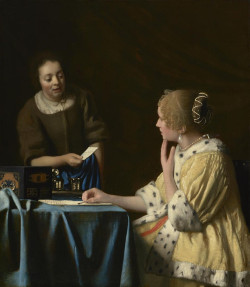Mistress and Maid
(Dame en dienstbode)c. 1666–1668
Oil on canvas, 90.2 x 78.7 cm. (35 1/2 x 31 in.)
Frick Collection, New York
acc. no. 11.1.126
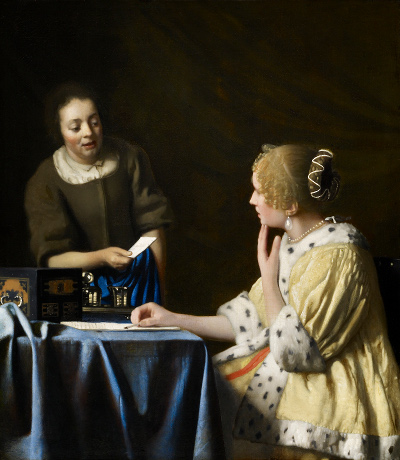
The textual material contained in the Essential Vermeer Interactive Catalogue would fill a hefty-sized book, and is enhanced by more than 1,000 corollary images. In order to use the catalogue most advantageously:
1. Scroll your mouse over the painting to a point of particular interest. Relative information and images will slide into the box located to the right of the painting. To fix and scroll the slide-in information, single click on area of interest. To release the slide-in information, single-click the "dismiss" buttton and continue exploring.
2. To access Special Topics and Fact Sheet information and accessory images, single-click any list item. To release slide-in information, click on any list item and continue exploring.
The motif

The sudden delivery of a letter raises doubts about the importance of the one the mistress is writing. Who could be the sender of this pressing correspondence? Instead of placing the subjects in a recognizable household setting, the drama and constructed nature of the composition is heigthened by positioning the women against a muted background with only a faint hint of drapery.
The theme of a mistress and maid set in an upper-class domestic environment was immensely popular among Dutch genre painters. This motif allowed artists to reflect on contemporary fashions and the unique relationship between women of different social ranks. Vermeer explored this theme three times: first in the painting discussed here, followed by Woman Writing a Letter with her Maid and the later work, The Love Letter.
Vermeer meticulously delineates the maid's lower social status. She is dressed in a plain-colored wool outfit paired with a utilitarian blue apron, and her dark hair is drawn back simply. In contrast, the mistress wears an elegant fur-trimmed jacket and appears to have embraced the latest hairstyle. Her luminous blonde hair is adorned with numerous precious pearls. Although their attire clearly conveys the maid's lower social standing, in all three works, the maid is depicted higher than her seated mistress within the composition, subtly challenging this hierarchy.
In this painting, Vermeer captures the exact moment the plainly dressed maid hands a letter, likely a love letter, to her mistress. The maid's respectful stance suggests she plays a neutral, perhaps even supportive, role in the scene.
The head of the mistress
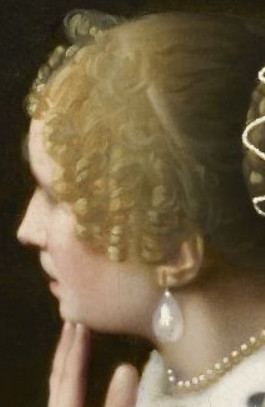
The head of the mistress is among Vermeer's finessed renderings of female physiognomy, even though a few art specialists have advanced that the passage in unfinished. The perfection of her features is reminiscent of classical models. Walter Liedtke, one of the most insightful Vermeer experts, associated this with the pictorial sensitivities of Michael Sweerts, Cesar van Everdingen, Caspar Netscher and Karel du Jardin.
The slightly blurred contour of the mistress' profile brings to mind one critic's description of the girl's face in Girl with a Pearl Earring as "the sweetest line ever painted." The minimalistic representation of her anatomical features is remarkable and is rarely matched in Dutch art. Her elusive gaze is captured with mere strokes of grayish paint, devoid of any clear linear definition. As with the subject in this work, none of the women who posed for Vermeer's paintings have been identified.
The writing set

Man Writing a Letter
Gabriel Metsu
c. 1664–1666
Oil on wood panel, 52.5 cm × 40.2 cm.
National Gallery of Ireland, Dublin
Writing sets typically included a plate with two small cup-like vessels with lids: one for ink and another for blotting sand or pounce (later taking the form of a salt shaker), as well as a holder for quills. More refined sets, as seen in Vermeer's A Lady Writing or Mistress and Maid, featured one or two drawers to store writing tools, such as quills, a pen-knife, signets and sealing wax.
Silver writing sets of the time were exquisite pieces of craftsmanship. Created by skilled silversmiths, these sets were meticulously detailed, often engraved with intricate designs, family crests or the initials of their owners. Made primarily from silver, they shone with a lustrous sheen, immediately distinguishing themselves from the more common wooden or brass sets.
While Vermeer's portrayal of the writing set is somewhat indistinct, it likely resembled those depicted frequently in letter-writing paintings from the same era. Both a writing set and a popular writing manual from that time are evident in Gabriel Metsu's Man Writing a Letter.
Letters in the Netherlands
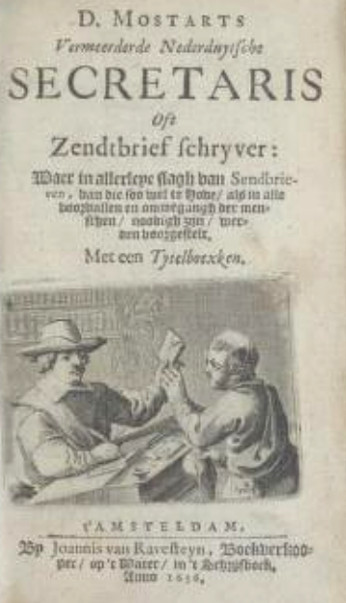
Title page from D. Mostaert's
Vermeerderde Nederduytsche
Secretaris oft zendtbrief schryver
(Amsterdam 1656)
Koninklijke Bibliotheek, The Hague
The Maid and Mistress portrays two letters, one sealed and the other unfinished. While the initial lines of the opened letter are visible, no words can be deciphered. However, scholars believe it to be a love letter.
In the Netherlands, the necessity of letters for the vast Dutch trade empire led to a proliferation unmatched in other European countries. Non-commercial letter-writing and calligraphy manuals were published in large quantities to guide and motivate the upper echelons of society. A particularly popular manual that Vermeer's young mistress might have known is Jean Puget de la Serre's Le Secrétaire à la Mode, translated into Dutch in 1651. This guide provided letter-writing tips and samples for various social scenarios. Approximately one-fifth of its content pertained to love letters. Within, readers found a selection of template letters expressing different levels of affection and commitment, each paired with a spectrum of potential replies, ranging from modest encouragement to definitive rejection.
The yellow fur-trimmed morning jacket
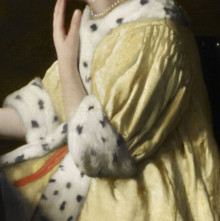
This garment is featured in five other paintings by Vermeer, but it is depicted with particular detail and care in the present work. Such a jacket was known as a jak, occasionally termed in Delft as a mantelje, and was donned by middle- and upper-class women. It provided an elegant shield against the chill of the prolonged Dutch winters while they carried out domestic tasks. However, it wasn't an attire for formal events, and it never appears in any formal portraits.
This jacket likely is the same as the one in Woman with a Pearl Necklace and Lady Writing. The distribution of the black marks beneath the collar and the creases formed by the piping on the sleeve in the forefront align quite precisely.
Contrary to the earlier works of art, in this piece, the rigidity and tangible presence of the jacket are accentuated by the chiaroscuro contrast and the thick and dynamic brush strokes that align with the fabric's creases. The black dots on the fur edging, perhaps not genuine ermine but added to a lesser fur like cat or squirrel, are portrayed with heightened detail and contrast. The vigorous depiction of the jacket accentuates the mistress's state of anxiety as she seeks to divine the message of the newly received letter.
In Vermeer's death inventory from 1676, a yellow satin mantle with white fur trimmings was discovered in the groote zael (grand hall) of the artist's residence, probably owned by his spouse, Catharina Bolnes.
The blue tablecloth

Although the still life of this painting is very similar to that of the earlier A Lady Writing, the stronger illumination scheme of Mistress and Maid produces a sharper contrast between the lights and darks on the folds of the blue tablecloth, giving them a life of their own. Recent research ahs determined that the tablecloth may have originally been a shade of green. It looks blue today due to the fading of a yellow lake, but retains its modeling and visual impact. Notably, the inventory of Vermeer's estate includes a green tablecloth. Since he was an artist keenly interested in direct observation, it is probable that elements of this composition are depictions of his own possessions.
Scientific analysis shows that the talbeclothe of the Mistress and Maid was underpainted with viridian, a deep, brilliant green, although it is not known if this hard-to-manage pigment was used to speed up the drying time of the lower level underpainting or as a base color to intensify the upper level of blue painting.
The dark background
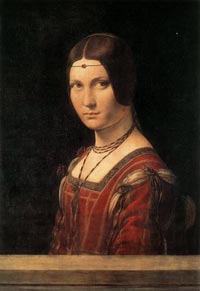
La belle Ferronière
Leonardo da Vinci
c. 1490
Oil on wood, 63 x 45 cm.
Musée du Louvre, Paris
Dark backgrounds, from Leonardo da Vinci onwards, have been widely used in portraiture to isolate the figure from distracting elements and enhance the sitter's three-dimensional presence. A few Norther artists, such as Michael Sweerts, who may have inspired Vermeer's Girl with a Pearl Earring, also used black backgrounds in figural groups.
Although the dark background adds to the dramatic effect of this composition, it was not part of Vermeer's original compositonal concept. Observing the painting directly, one can identify a series of sweeping diagonal shifts in tone behind the figures, suggesting the presence of a drawn-back curtain. The curtain, which must have been rather dark, might have been painted with the pigment verdigris, which is highly prone to darkening. However, recent discoveries indicate that the curtain was, just as the dark background we see today, not Vermeer's original design. In fact, after a multi-year investigation, the Metropolitan Museum of Art in New York conservation team revealed several years ago that the Delft master initially painted a detailed tapestry behind the women in this painting, depicting at least four large figures similar in style of the tapestries in Girl with a Flute and Girl with a Red Hat, which, conceivably, might have been experimental pieces that inspired the tapestry solution for the more ambitous Mistress and Maid.
The conservation team have also suggested that evidence of the original figural elements in the background seems to be supported by the vertical section on the far right of the design, which appears to represent a sculpture in a niche and could be an elaborate border encompassing the tapestry’s central scene.
Although the original source of Vermeer’s background inspiration remains unidentified, a Flemish tapestry designed by Jacob Jordaens offers a relevant comparison. This tapestry features a robust female figure in a pose reminiscent of the one visible in Mistress and Maid, near the mistress's profile. Hanging garlands and borders adorned with statues also align with elements are also revealed by the IRR scans.
Acoording to the conservation staff, another possibility is that the unresolved portion of the composition was a large picture-within-a-pictures that hung on the background nwall. Some contours of the figures resemble those in a painting, the subject of which is described as the finding of Moses, visible in Vermeer's Astronomer and A Lady Writing a Letter with Her Maid. Whatever this intricate design was intended to portray, Vermeer may have felt it detracted from the central narrative and decided to exclude it from the final composition and pained over the drak green curtain, an innovation that he subsequently applied to the Girl with a Pearl Earring and Study of a Young Woman.
The fancy veneered casket
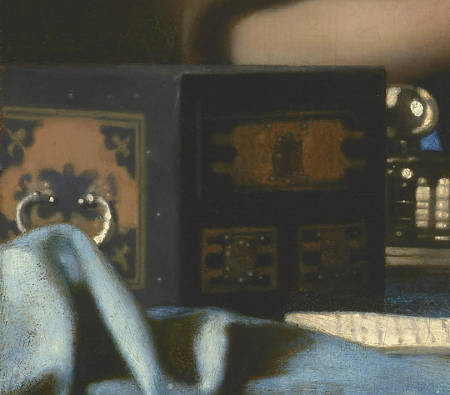
On the table is a wooden coffer crafted from differently colored woods and fitted with glittering silver mounts. Sometimes described as a jewel casket, it is perhaps more likely to be a writing box, used to store writing supplies or a secret cache of letters and other precious items. The design of the coffer suggests it is of Indo-Portuguese origin, produced in the Goan region and imported into Europe by Dutch or Portuguese traders. Both objects, arranged in a slightly different manner, appear in another painting by Vermeer, A Lady Writing. Some critics have speculated on the purpose of the casket was to hold jewelry or in this case, an even more precious commodity, the love letters of the mistress. This kind of writing set was represented in numerous canvases of Vermeer's contemporaries such as Nicolaes Maes, Gabriel Metsu and Gerrit ter Borch. In any case, such a casket would have been identified as a luxury item.
The maid in Dutch painting
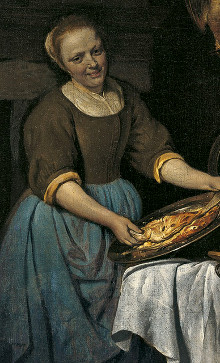
The Cook
Gabriel Metsu
1657–1667
Oil on canvas, 40 x 34 cm.
Museo Thyssen-Bornemisza, Madrid
As maids became an indispensable part of Dutch upper-class life, genre painters, who catered to this class's aspirations, depicted them numerous times in various attitudes. Their working attire, however, seems to have been fairly standardized. In fact, the maid in Gabriel Metsu's The Cook is dressed almost identically to the maid in the current work by Vermeer.
Unlike the grinning maid in Vermeer's later Love Letter, who appears quite informed about the content of the letter she has just delivered, her neutral facial expression and respectful demeanor in the present painting suggest a relatively passive role in the story. Her open mouth might indicate she has just announced the letter's arrival, contributing to a suspenseful moment in Vermeer's quiet narrative.
How did Dutch maids behave? In theory, maids were hard-working, supportive and loyal. However, the reality could differ. In emblematic literature and popular theater of the time, maids often posed a threat to the security of the home, the heart of Dutch life. As Simon Schama noted, in the 17th century, "maids were indisputably regarded as the most dangerous women of all..."
In Northern Europe, maids often appeared in a more neutral role, either caring for children or being overseen by the mistress of the household. A few painters, including Vermeer in The Milkmaid, depicted them with dignity and compassion. Pieter de Hooch also portrayed them sympathetically during his Delft period, illustrating their diligent assistance to their mistress or their care for the household's children.
The mistress' gown
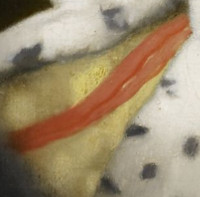
The red stripes of vermilion, which enhance the characteristic yellow/blue harmony of the painting, represent two ribbons used to tie the yellow gown. Ribbons of a similar color appear between the opening of the figure's jacket in Vermeer's earlier work, Woman Holding a Balance.
special topics
Critical assessments
Departing from the traditional iconography of the letter writer, Vermeer nevertheless relied upon the underlying thematic content to give poignance to his scene. The mistress' expression reveals the uncertainties of love that disrupt the serenity of ordered existence. The mistress' controlled demeanor and fashionable wardrobe seem to suggest that such fleeting doubts affect even those who are most secure and content in their lives. The maid, while offering the letter, responds to her mistress' gaze with a caring yet concerned look. With her slightly opened mouth and lowered eyelids, her expression is as restrained as her mistress', yet Vermeer created a visual dialogue between them that conveys the intense psychological impact of the letter's arrival.
Arthur K. Wheelock, Vermeer and the Art of Painting, 1995
The signature
No signature appears on this work.
(Click here to access a complete study of Vermeer's signatures.)
Dates
c. 1666
Albert Blankert, Vermeer: 1632–1675, 1975
c. 1667–1668
Arthur K. Wheelock Jr., The Public and the Private in the Age of Vermeer, London, 2000
c. 1666–1667
Walter Liedtke, Vermeer: The Complete Paintings, New York, 2008
c. 1667–1668
Wayne Franits, Vermeer, 2015
(Click here to access a complete study of the dates of Vermeer's paintings).
Provenance
- (?) Pieter Claesz. van Ruijven, Delft (d. 1674); (?) his widow, Maria de Knuijt, Delft (d. 1681);
- (?) their daughter, Magdalena van Ruijven, Delft (d. 1682);
- (?) her widower, Jacob Abrahamsz Dissius (d. 1695);
- Dissius sale, Amsterdam, 16 May, 1696, no. 7;
- sale, Amsterdam, 15 October, 1738, no. 12 (to Oortman);
- probably Van Helsleuter et al. sale, Paris (Paillet), 25 January, 1802, no. 106 (bought in);
- [Ch. Lebrun, Paris];
- sale, Paris (Paillet), 16 January, 1809, no. 34 (to Lebrun);
- Lebrun sale, Paris, 20 March, 1810, no. 143 (to Chevallier);
- sale, Paris (Paillet), 24 March, 1818, no. 48;
- Dufour, Marseilles (from 1819 or earlier);
- Duchesse de Berry sale, Paris, 4–6 April, 1837, no 76 (to Paillet);
- E. Secrétan sale, Paris, 1 July, 1889, no. 139 (to Sedelmeyer);
- A. Paulovstof, St. Petersburg;
- [Lawrie & Co., London]; [Sulley & Co., London, in 1905];
- James Simon, Berlin (?1906-at least 1914);
- [Knoedler, New York];
- Henry Clay Frick, New York (in 1919; d. 1919);
- The Frick Collection, New York (acc. no. 11.1.126).
Exhibitions
- Paris 1889
Catalogue of the celebrated collection of paintings by modern and old masters and of water colors and drawings formed by Mr. E. Secrétan
Charles Sedelmeyer Galleries
138, no. 139 and ill., as "The Lady and the Servant," from the collection of Dufour Marseille) - New York 3 June–2 November, 2008
Frick's Vermeers Reunited
Frick Collection - Amsterdam February 10– June 4, 2023
VERMEER
Rijksmuseum
no. 22 and ill. - Dublin May 11, 2024–August 18, 2024
Vermeer Visits
National Gallery of Ireland, Dublin - New York June 18, 2025–September 8, 2025
Vermeer’s Love Letters
Frick Collection
(Click here to access a complete, sortable list of the exhibitions of Vermeer's paintings).
Two women: vis-à-vis
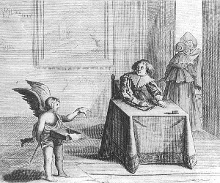
Cupid Presenting a Letter to a Maid
Emblem from Jan Harmenz. Krul, Pampiere Wereld
(Amsterdam, 1644), vol. 2
Koninklijke Bibliotheek, The Hague
Vermeer often depicted figures interacting in the intimacy of a well-appointed home. Gerrit ter Borch elevated this motif to near perfection. His unparalleled ability to portray the psychological undercurrents underlying relationships is evident.
Though the narrative in this work seems straightforward, its psychological nuances are multifaceted. Two themes subtly interweave. On one side, the elegant mistress contemplates the arrival of a sealed love letter, hinting at a connection with someone far away. Conversely, the nuanced relationship between the mistress and her assistant, the maid, emerges through discreet glances and body language.
The mistress's psychological ambivalence is subtly communicated by her contemplative gaze, which the artist prevents us from fully grasping, her slightly opened lips and the inquisitive gesture of her fingertips nearing her chin. The maid's gaze, while more overt, remains inscrutable. Her parted lips don't reveal the words she might have just uttered, but the respect in her posture casts her in a supportive role. What does the mistress know about the impending letter? Is she composing a response to its sender? And does the maid have deeper insight into the letter due to her intermediary position?
The nuances behind the brief exchange of words and looks between the two women, akin to the yet-to-be-opened letter, pause indefinitely, inviting each observer to interpret the scene based on their own experiences and anticipations.
A special painting technique
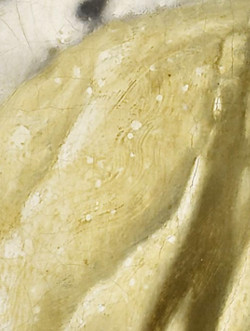
The canvas appears to be in generally good condition, despite the fading of the background tapetry and the in change in color of the once-green tablecloth. The other colors likely remains as vibrant as when the canvas first stood on the artist's easel. However, this work exhibits several stylistic and technical peculiarities: the notably large scale of the figures and the distinctly pronounced modeling.
More than most Dutch interior painters, Vermeer adjusted his paint application on the canvas to capture texture and light interplay. Each object was painted according to its narrative importance in the picture, its distance from the viewer, its illumination and its texture. Shadows were rendered with veils of semi-opaque dark washes of oil-rich paint to suggest the immaterial quality of shadows. The contours of some objects are strongly blurred, while those of others are nearly razor-sharp. Some objects could be painted in one go, while the colors of others required two or more layers, generally referred to as glazes. This variation gives Vermeer's cavases a unique visual richness that goes far beyond mere resemblance. For instance, the lit sections of the yellow jacket feature luxurious, broad brushstrokes of lead-tin yellow, while the shadows are delineated with impressing precision. This technique gives a radiant, tangible sense of light not seen in his other depictions of the same garment. Conversely, the seated mistress's skin displays tonal transitions so subtle and refined that they faithfully capture the transparency and finesse of the mistress's porcelain-like complexion. By comparison, the head of the maid seems almost sculptural.
The masterful simplicity with which the mistress's profile is depicted is especially striking. Upon closer observation, the anatomical details of her eye are replaced by a few nebulous smudges of light gray paint, yet viewers immediately perceive her wary gaze.
The folded letter in the maid's hand is accentuated with a thick application of lead white, producing a tactile relief not evident in reproductions. This emphasizes the letter's pivotal role in the painting's narrative anchoring the mistress to her maid.
A quill pen & an open letter
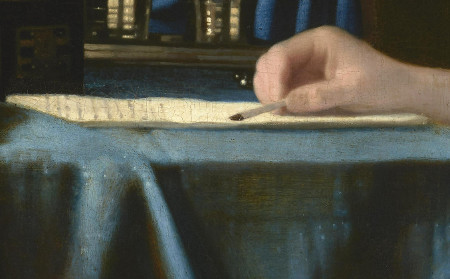
One can easily recognize the ink-stained tip of the woman's quill, momentarily at rest as she briefly contemplates the arrival of a missive. On the open letter, about ten written lines, indicated by delicate dabs of light-gray paint, can be discerned.
Introduced around 700 A.D., the quill pen was the dominant writing instrument until the 19th century, replaced later by the dip pen and then the fountain pen. Writing quills were made from the feathers of large birds, with the primary choice being geese. The feathers from the left wing of the goose were especially favored because they curved to the right, making them more comfortable for right-handed writers. In addition to goose feathers, swan and turkey feathers were also used to make quills.
Quills needed frequent sharpening with a special "pen-knife" (as seen in paintings by Frans Mieris or Gerrit Dou). These quills lasted only about a week before needing replacement. This is why in paintings depicting lawyers or scholars in their studios, we sometimes see several quill pens lying on the desk. A hand-cut goose quill pen remains the preferred tool for calligraphy, offering a sharp stroke with more flexibility than a steel pen.
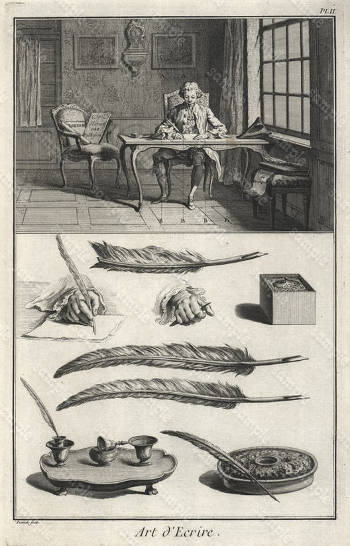
"Ecritures," Encyclopédie ou Dictionnaire raisonné des sciences, des arts et des métiers
Denis Diderot
Paris, 1763
Around 400 A.D., a stable form of ink was developed, comprised of iron salts, nutgalls and gum—forming the foundation for iron-gall inks. Despite its potential downsides—gradual fading and weakening the paper—it was the chosen ink from the Middle Ages to the 20th century. Iron gall inks were certainly used in the 17th-century Netherlands, as throughout Western Europe. With the Netherlands' expanding trade, Chinese Indian ink became available and was soon preferred for special (official) documents due to its enhanced durability and saturation. Lawyers, for example, might have favored this ink. A close examination of Vermeer-related documents suggests that Vermeer (and Catharina) signed using the lawyer's ink, likely an Indian ink. The shade appears distinct and dark, with no brownish fading (as seen with iron-gall inks) and no weakening of the robust paper.
An abundance of pearls
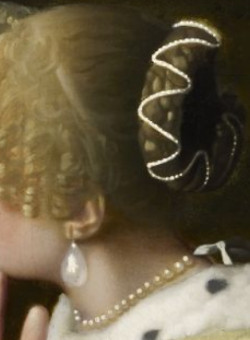
In no other painting by Vermeer do we find such an abundance of pearls. The comely mistress wears a pair of oversized drop earrings, a pearl necklace and strings of pearls arranged in courtly fashion. No scholar has remarked upon their eventual iconographic meaning, they seem to have been simply included for their purely aesthetic value and as a means for defining the social standing of the mistress.
Pearls were an important status symbol of the age and they held for the educated Dutch picture-viewer a number of associations, some of them, ranging from vanity to truth, contradictory.
Since ancient times, the pearl has been a symbol of unblemished perfection. It is the oldest known gem, and for centuries it was considered the most valuable. To the ancients, pearls were a symbol of the moon and had magical powers. In classical Rome, only persons of an elevated social rank were allowed to wear pearl jewelry. The Latin word for pearl literally means "unique," attesting to the fact that no two pearls are identical. In many archaic cultures the marine shell, because of its appearance, is associated with the female genitalia, and the pearl is believed to be both the sacred product and the emblem of the feminine generative power. The pearl thus symbolizes both the life that is created and the mysterious force that generates life. Analogous to the pearl's origin, Aphrodite was born from a marine conch.
Why are the figures so large?
Wherever its position in the chronological order of Vermeer's oeuvre, the scale of the figures in Vermeer's Mistress and Maid comes as a surprise. Although not life-size, these figures are the largest ever painted by Vermeer, aside from those in the early Procuress.
What is puzzling is that the work's straightforward domestic theme does not seem to demand a larger format.
While large-scale human figures were not uncommon in Dutch interior painting, they were typically reserved for history paintings. These paintings were primarily created for public viewing and conveyed significant religious or civic messages. Civic group portraits, like Rembrandt's Night Watch, were frequently commissioned for public structures and could achieve nearly monumental proportions. Another genre that embraced large-scale figures was the flamboyant Dutch Caravaggesque brothel scene, which featured opulently attired prostitutes. Their primary role seems to have been to captivate the viewer's gaze while beguiling her depicted client. In contrast, the subdued intimacy of interior genre paintings typically employed the smaller "cabinet" format, inviting viewers to approach and intimately engage with the narrative.
In Vermeer's time, paintings were sometimes produced in relation to a particular environment in which they would be viewed. Paintings that portray light coming from left to right—which comprise the overwhelming majority—were, when possible, hung to the right of an open window. The horizon line of Dutch landscapes was often aligned to the average height of the viewer's eyes.
In the Mistress and Maid, the compositional simplicity, the dramatic effect of large-scale confrontational figures and vibrant coloring may suggest that the work was intended to be viewed from a distance, such as the end of a hallway. Alternatively, and perhaps more intriguingly, the artist might have been eager to explore how his well-established techniques for interior scenes would translate to the grandeur of history painting.
Listen to period music
![]() Jan Dismas Zelenka
Jan Dismas Zelenka
Trio sonata ZWV 181, no. 4, Adagio [1.18 MB]
http://www.amazon.com/Jan-Dismas-Zelenka-Knut-Sonstevold/dp/B0008FMHQW/ref=sr_1_9?ie=UTF8&s=music&qid=1258287965&sr=1-9
Vermeer's skin tones
With its grand dimensions, the treatment of human flesh in the present painting is more evident than in the tiny figures of his cabinet-sized interiors. The flesh of the maid has a tawny, olivaster tint, while that of the mistress is a clear, impalpable pink. This difference, perhaps, was meant to differentiate the maid's lower and the mistress' higher social standing, as fair skin (and blond hair) was, in those times, a prime attribute of beauty.
From the dawn of European easel painting, the depiction of human flesh was given great importance and still constitutes one of the most telling technical challenges for the artist. Willem Beur, a painter and art writer of Vermeer's time, wrote, "Just as we humans consider ourselves the foremost amongst animals; so too, are we the foremost subject of the art of painting, and it is in painting human flesh that its highest achievements are to be seen. Whenever a painter succeeds in rendering the diversity of colors and strong hues found in human flesh, particularly in faces, he is adequately depicting the intricacy of the diversity of people or their different emotions." This is why, in depictions of artists working in their studios, the painters' palettes were almost always set with the pigments necessary for painting flesh.
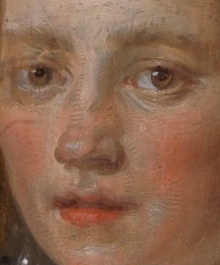
Portrait of a Young Woman (detail)
Gerrit Dou
c. 1655
Oil on oak, 14.5 x 11.7 cm.
National Gallery, London
It would appear that Vermeer did not assign the same hierarchical importance to the painting of flesh as did the best Northern painters. Aside from the Mistress and Maid, Study of a Young Woman and the Girl with a Pearl Earring, the artist's flesh tones lack the opalescent freshness of Rubens' women, the nuances of Rembrandt's portraits or even the rosy, albeit formulaic, complexions of Gerrit Dou's pretty damsels. From a technical point of view, Vermeer's faces appear to be painted adequately; a few under par. We have the impression that for the artist, the definition of female physiognomy or the rendering of the flesh was investigated with the same care with which he might paint a porcelain wine jug or the intricate design of a Turkish carpet.
Perhaps the most compelling depiction of nude female flesh can be seen in the mistress of the current painting. The pearlescence and luminosity of her skin bestow upon her an ethereal perfection that strikingly contrasts with the olive complexion of the maid.
As Thijs Weststeijn noted, "In the 17th century, the capacity to transform inert pigment into lifelike skin was equated to the alchemical process of transubstantiation. Numerous instances in art literature highlight this process. Dolce asserted that Titian's proficiency in color made his figure seem alive, suggesting that "it moves, and its flesh pulses" (Le carni tremano). This prowess in embodying the human form in paint subsequently led to the frequent juxtaposition of blood and paint." Art historian Paul Taylor points out that Dutch painters paid special attention to the "glow" of the flesh or 'gloeyend', alluding to the vitality that appears to course beneath the skin.
Though artists utilized a limited array of pigments to depict human skin, there wasn't a universal method for flesh painting throughout history. Typically, artists leaned on a few foundational colors—white, yellow ochre, vermilion, both raw and burnt umber, red madder and black. They maximized the inherent qualities of each pigment and the visual effects of layering, such as the turbid medium effect.
A commonly employed method for capturing fair skin tones—especially prominent in Northern regions like the Netherlands—combined white and vermilion. The latter is a potent red pigment characterized by its vivid orange hue.
In any case, the 17th-century Netherlands, skin color held significant cultural and societal implications, reflecting not just beauty standards but also social hierarchies and economic status. Pale, fair skin was particularly favored by the elite, symbolizing a life of leisure, luxury and freedom from manual labor. The reason for this preference is rooted in the societal norms of the time: those with sun-tanned or darker skin were often associated with outdoor labor, implying a lower socioeconomic status. Olive skin belonged to Souther European cultures. As fair skin (and blond hair) were considered prime attributes of beauty, these features became emblematic of the societal ideal, further emphasizing the divide between the classes.
Well-to-do women employed various methods to protect their complexion from the sun. Parasols or sunshades were common accessories. Additionally, women wore wide-brimmed hats or bonnets, further ensuring that their faces remained untouched by the sun's rays.
A faded tablecloth
The prosaic blue cloth is presumably the same found in other works by Vermeer, including Woman with a Lute, Woman with a Pearl Necklace and Woman Holding a Balance. In each work—in Woman Holding a Balance it is more intense—the cloth has a slightly different color. The relative drabness of the other two paintings is likely due to the degradation of the blue pigment used for the passage. In the present work, the blue is quite clean.
Although the tablecloth does appears to be blue, passages of an original bright transparent green along the left perimeter of the painting that had been protected from light exposure by the picture's frame were observed when the painting was examined with a stereomicroscope. This observation raised questions as to whether there had been a color change here as well. Alhough originally green, it still still its expert modeling and visual impact. The discovey of the original color is not surprising because Vermeer’s probate estate inventory includes a green tablecloth. It seems likely that he modeled elements of this composition after objects he owned, another detail that can deepen our connection to this exceptional artist, as this technical study has revealed.
A missing tapestry

For many years the dark background of the painting has caused considerable debate in that it is the only genre scene by Vermeer not staged in a contemporary setting. This prompted some critics to believe the background was not by Vermeer's hand, even though on close inspections it shows what appear to be remnants of a large curtain with large diagonal folds.
Surprisingly, in a recent examination of the painting by the Metropolitan Museum of Art, an infrared reflectogram (IRR) revealed that the background was covered with a large tapestry, most likely in the manner of Vermee's Girl with a Red Hat. The reflectogram revealed multiple large-scale with a section that seems to represent a sculpture in a niche as well as hanging garlands, which bring to mind certain Flemish-style tapestries designed by Jacob Jordeans. It is believed that Vermeer painted out the tapestry himself and added a sweeping green curtain to draw focus to the foreground figures. The original green color of the curtain has so degraded that it cannot generally be seen in reproductions.
One of the first paintings by Vermeer to be reproduced
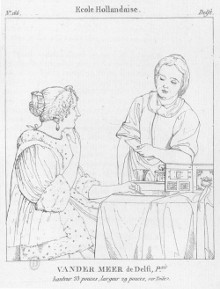
Jean-Baptiste Pierre Le Brun, one of the most gifted connoisseurs of late eighteenth- and early nineteenth-century France, was trained as a painter and took over his father's art business in 1771. He is noted for having written in various publications about artists and artistic education, predominantly about the painters of the schools of the north. Between 1792 and 1796, Le Brun published a comprehensive survey of northern school painters titled Galerie des peintres flamands, hollandais et allemands, which listed 1,350 Flemish, Dutch and German artists known to him at that time. The vast editorial project was published in both Paris and Amsterdam and was partly financed by Pierre Fouquet Jr., Le Brun's principal business partner in the Netherlands.
After the Galerie, he published Recueil de gravures au trait, which contained a series of simplified engravings of paintings he acquired during a journey in 1807 and 1808. In the Recueil, he discussed Vermeer's Mistress and Maid, the second work by Vermeer ever to be reproduced. In total, Le Brun handled two Vermeer paintings; one was Mistress and Maid, which he sold in 1811. Le Brun emerged as the primary reference for enthusiasts of the then lesser-known Dutch master, marking the beginning of Vermeer's rising reputation in France.
Le Brun's extensive contributions to art documentation, particularly regarding northern painters, had lasting impacts beyond his lifetime. His meticulous records, in-depth critiques and engagement with the art of his time not only positioned him as a cornerstone of art history but also paved the way for future connoisseurs and historians. The trajectory of Vermeer's recognition, in particular, might have been different without Le Brun's spotlight on his works. This emphasizes the significant role that such scholars play, not only in preserving art but in shaping its legacy and influence for future generations.
